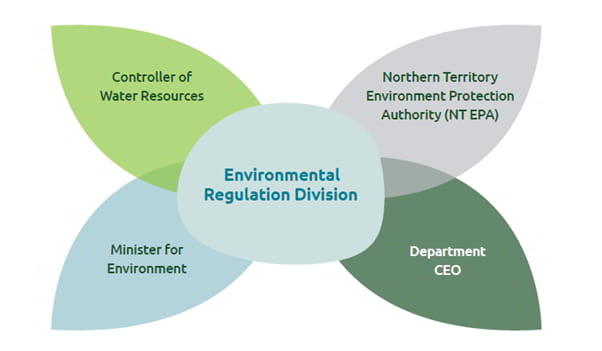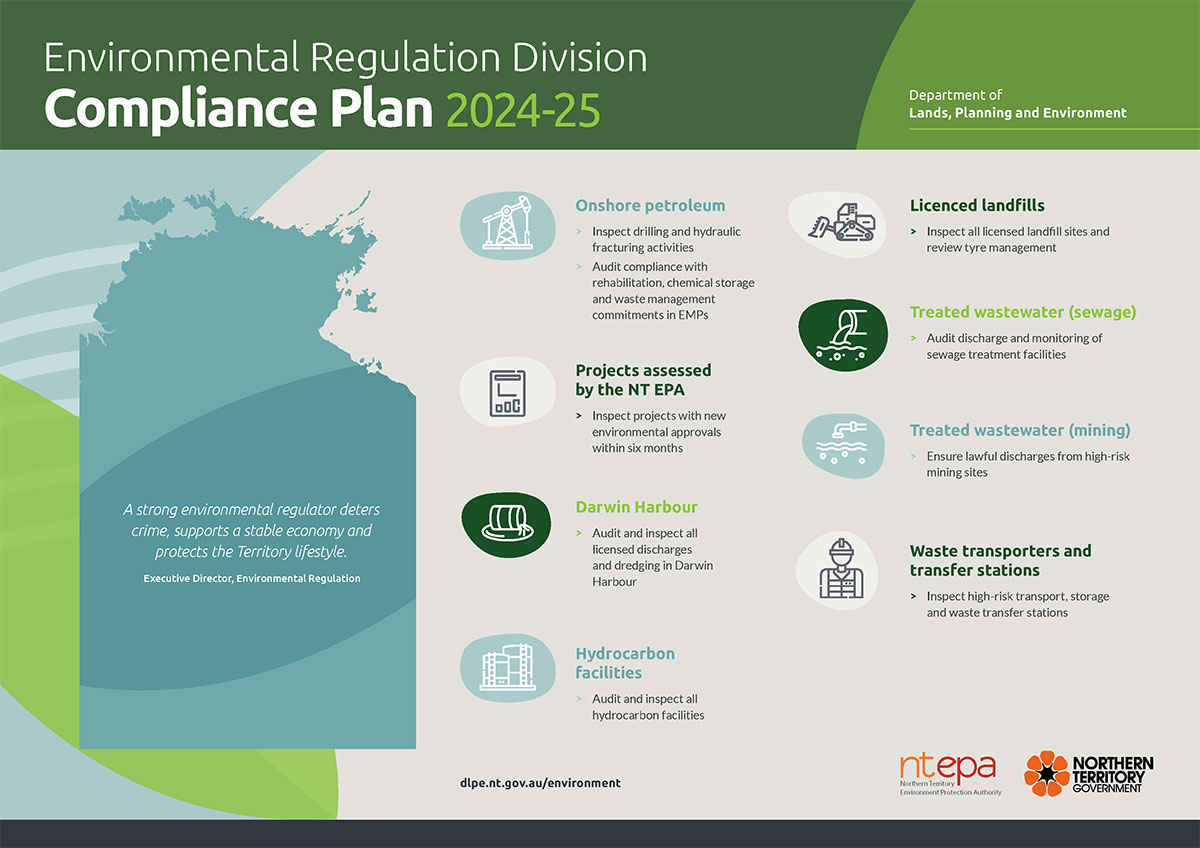The Environmental Regulation Division
The Environmental Regulation Division in the Department of Lands, Planning and Environment supports four statutory decision-makers in the Northern Territory, including the NT EPA. We also support the Minister for Environment, the Chief Executive of the Department, and the Controller of Water Resources.

Our purpose is to strike the right balance between protecting the environment and enabling development. To do this we apply, monitor and ensure compliance with the law.
We are a risk-based regulator and we apply our PACTT principles to all our regulatory functions.
| Proportionate | Our compliance and enforcement activities are proportionate to the seriousness of the conduct and the resulting or potential harm. |
|---|---|
| Accountable | Activities and decisions are explained and avenues of complaint or review are available and accessible. |
| Consistent | Similar circumstances lead to similar enforcement approaches, where appropriate. |
| Targeted | We allocate effort and resources to the areas with the potential for most serious harm. |
| Transparent | Information about the Division’s activities is shared and enforcement actions are made public. |
*Pink, G., Navigating Regulatory Language: An A to Z Guide, (2021)
We apply the PACTT principles to all our regulatory functions:
- advice and guidance
- licensing and approvals
- monitoring compliance
- enforcement
- regulatory performance and evaluation.

See below for more information on our monitoring compliance and enforcement functions.
Monitoring compliance and enforcement
To build a culture of compliance in the regulated community —where individuals, business and industry take responsibility for ensuring that their activities do not cause unlawful environmental impacts—the Division monitors compliance and sometimes needs to take enforcement action.
Read our Approved Compliance and Enforcement Policy PDF (871.3 KB) for information on our regulatory approach. We abide by the following best practice principles:
There are a range of compliance and enforcement tools available to the environmental regulator in the Waste Management and Pollution Control Act 1998:
- penalty infringement notices
- environment protection approvals
- environment protection licences
- compliance plans
- pollution abatement notices
- incidents reported in accordance with section 14 of the Act (Section 14 Incident Report(s))
- environmental audits
- performance agreements
The most appropriate compliance and enforcement tool to use will always depend on the circumstances.
The Division will consider the likelihood of the risk occurring, the potential environmental harm, and the offender’s attitude to compliance when considering the most appropriate compliance and enforcement tool.
The Compliance pyramid diagram below shows the proportionate use of compliance and enforcement tools in our toolkit and the ability to escalate intervention to achieve the desired outcome.

The Division’s enforcement guideline PDF (903.9 KB) contains greater detail about our compliance and enforcement tools under many environmental laws.
Find out more information on the Role and Powers of Appointed Officers.
Our compliance priorities
Our commitment to applying our PACTT principles includes publishing our compliance priorities in annual compliance plans and comparing our performance against them in compliance report cards.
Commencing in 2023, the Division publishes an annual compliance plan to provide transparency on where the regulator will focus its efforts to protect the community and the environment. It recognises issues that are important to the community and provides guidance to the regulated community about our expectations.
Read our Environment Compliance Plan 2024PDF (286.3 KB), it focuses on the following industries:
- Onshore petroleum.
- Projects assessed by the NT EPA.
- Darwin Harbour.
- Hydrocarbon facilities.
- Licenced landfills.
- Treated wastewater (sewage).
- Treated wastewater (mining).
- Waste transporters and transfer stations.
The plan provides assurance that the regulator is focussing on the environmental risks that can cause the greatest harm. We keep ourselves accountable to our compliance plans and report back on how we delivered them in our annual Compliance Report Card PDF (906.2 KB).
Read past compliance plans:
While we always prioritise matters in the plan, we retain capacity and have discretion to pursue other matters, always in line with our Compliance and Enforcement Policy.
